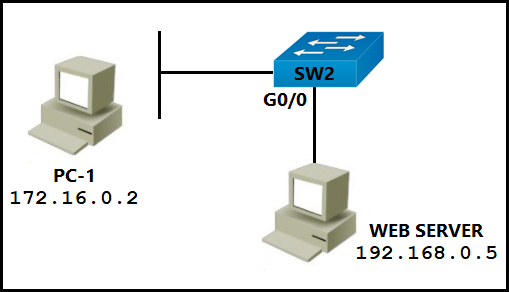
Refer to the exhibit. PC-1 must access the web server on port 8080. To allow this traffic, which statement must be added to an access control list that is applied on
SW2 port G0/0 in the inbound direction?

Refer to the exhibit. PC-1 must access the web server on port 8080. To allow this traffic, which statement must be added to an access control list that is applied on
SW2 port G0/0 in the inbound direction?
To allow PC-1 to access the web server on port 8080, the access control list (ACL) needs to permit the traffic originating from PC-1's IP address (172.16.0.2) and targeting the web server's IP address (192.168.0.5) on port 8080. Therefore, the correct statement to allow this traffic is: permit tcp host 172.16.0.2 host 192.168.0.5 eq 8080.
The correct answer is C...
Just noticed the G0/0 is towards the web server NOT the PC...Then is permit host 192.168.0.5 eq 8080 host 172.16.0.2
Same here, looks like the G0/0 is the interface facing the PC but no, it is facing the SERVER, so the answer is C :)
Agreed. Its the traffic coming back from the initial connection. C is correct.
i hope whoever made this exhibit no longer works in cisco.
lol, its a bit tricky first thing i noticed was where int is facing
Be aware that G0/0 port is the one connected to the server. The catch here is that the ACE doesn't filter any ingress traffic from PC-1. It filters the inbound traffic from the webserver. So naturally, you need to permit the ingress traffic sourced at the web server.
The correct answer is C. Since the rule is to be applied Inbound to SW2 Gi0/0, we need to invoke the rule guiding Source Port and Destination Port. <protocol> <source IP/source network> <source port> <destination IP/destination network> <destination port> Therefore, permit tcp host 192.168.0.5 eq 8080 host 172.16.0.2
This question would be correct if the equipment would be a router not a switch. In that case C is correct.
Hi It is confuse the interfece name placement C is correct Regards!
Gig0/0 is facing the server
The inbound direction of G0/0 of SW2 only filter traffic from Web Server to PC-1 so the source IP address and port is of the Web Server.
C will not prevent the PC from accessing port 8080 on the webserver. Only the answer is not allowed, AFTER the access did already happen. Terrible question, terrible graph, everything terrible. I go for A
C. It asking for return traffic.
The correct answer is C...
C is correct the question states "Inbound direction" which means that if the PC tried to connect to the server, the server should have the ability to reply. so in reality you should have 2 access-lists one for traffic from PC1 to the server and another one for traffic from the server to PC1. the question is asking you in a tricky way about the traffic from the server to the PC1 just by stating "Inbound"
They could have placed the port label on the right side. I thought it was for the cable facing the PC...
Answer is C. The ACL is put on the interface facing the web server that receives a request on port 8080 ---> the answer has source port 8080 and is the web-server as the direction of the ACL is input (from outside to the router).
the obvious quick answer choice for most commonly seen deployments would be answer A. but since that is the only one with 172 as the source, there must be some trick going on! So after looking again, C it is, but this is not a typical ACL found almost anywhere and on a switch for that matter. dumb question for real life. also remember that ports can be applied to both source and dest, which means the port will follow each one. this rules out B as syntactically incorrect.
Question says "PC-1 must access the web server on port 8080" So I'd go for A where PC-1 is the source and server is the destination
If your ACL is in an outbound direction on the G0/0 A would be fine, but in this case the ACL is in a inbound direction meaning that it will be looking at traffic from the server to the PC